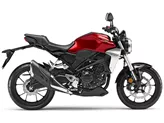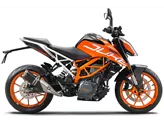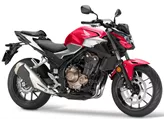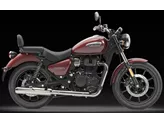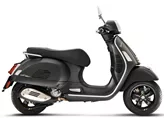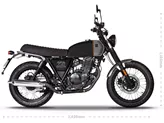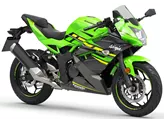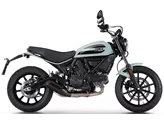Kawasaki Z 300 2016 vs. Honda CB300R 2018

Kawasaki Z 300 2016

Honda CB300R 2018
Overview - Kawasaki Z 300 2016 vs Honda CB300R 2018
The Kawasaki Z 300 model year 2016 and the Honda CB300R model year 2018 are both naked bikes that offer a thrilling riding experience. While they have some similarities in terms of their technical specifications, they also have distinct differences that set them apart.
Starting with the Kawasaki Z 300 2016, it boasts a powerful engine with 39 horsepower and 27 Nm of torque. It features a 2-cylinder liquid-cooled engine with a displacement of 296cc. The steel frame provides a sturdy and reliable chassis. The front brakes have double piston technology and a petal design, ensuring efficient and stable braking. The front and rear tires have a width of 110mm and a diameter of 17 inches, respectively. The wheelbase is 1405mm, providing stability and control. The seat height is 785mm, offering a comfortable riding position. With a kerb weight of 170kg (with ABS), it is relatively lightweight. The fuel tank has a capacity of 17 liters, allowing for longer rides without frequent refueling.
The strengths of the Kawasaki Z 300 2016 include its adult look and high-quality finish, giving it a premium appearance. The high-revving engine delivers exhilarating performance, while the comfortable seating position enhances the overall riding experience. The stable brake ensures safety, and the easy-to-read, complete cockpit provides all the necessary information at a glance. Additionally, the Z 300 has low fuel consumption, making it an economical choice.

Kawasaki Z 300 2016
However, the Kawasaki Z 300 2016 does have some weaknesses. The sound of the engine is very unobtrusive, which may not appeal to riders seeking a more aggressive and noticeable exhaust note. While the chassis components are favorable, the engine only starts when idling, which may be inconvenient for some riders.
Moving on to the Honda CB300R 2018, it features a slightly less powerful engine with 31 horsepower and 27.5 Nm of torque. The engine is a single-cylinder liquid-cooled with a displacement of 286cc. Like the Z 300, it also has a steel frame for a solid foundation. The front brakes have four pistons and radial technology, offering precise and responsive braking. The front and rear tires have a width of 110mm and 150mm, respectively, with a diameter of 17 inches. The wheelbase is slightly shorter at 1352mm, providing nimble handling. The seat height is 799mm, offering a slightly higher riding position compared to the Z 300. With a kerb weight of 143kg (with ABS), it is lighter than its counterpart. The fuel tank has a smaller capacity of 10 liters, which may require more frequent refueling on longer rides.

Honda CB300R 2018
The strengths of the Honda CB300R 2018 include its truly smooth handling, thanks to a well-designed chassis that offers both stability and comfort. The top build quality ensures durability and longevity. Additionally, it features IMU-ABS (Inertial Measurement Unit - Anti-lock Braking System) and full LED lighting, enhancing safety and visibility.
However, the Honda CB300R 2018 does have some weaknesses. The front brake may require more hand force than expected, which could be a disadvantage for riders who prefer a lighter brake feel. In terms of equipment, it is considered to be less equipped than its competition, which may be a drawback for riders seeking more advanced features.
In conclusion, both the Kawasaki Z 300 2016 and the Honda CB300R 2018 offer impressive performance and quality. The Z 300 stands out with its adult look, high-revving engine, and comfortable seating position, while the CB300R excels in smooth handling, stability, and build quality. Ultimately, the choice between these two models will depend on personal preferences and priorities.
Technical Specifications Kawasaki Z 300 2016 compared to Honda CB300R 2018
Pros and Cons in comparison
Pros and Cons in comparison
Kawasaki Z 300 2016

The cool design of the Kawasaki Z300, which is extremely similar to that of its big sister Z800, makes it a very grown-up-looking motorbike. The stable braking system and the easy-to-read cockpit with an analogue rev counter and all the necessary features fit in very well with this image. Thanks to the 170 kg ready-to-ride weight, the bike is extremely easy to handle and playful. The engine only reveals its potential in the upper rev range, but revs up willingly and makes you want to ride in a sporty manner. Only the comfort-oriented chassis cannot quite cope with radically sporty demands - but this is quite legitimate and understandable for an entry-level motorbike.
Honda CB300R 2018

The somewhat hackneyed saying "Performance isn't everything!" hits the mark with the new Honda CB300R. The bike could be sold as the epitome of lightness, both in terms of weight and handling. The high build quality in combination with the successful styling will certainly help to overlook the less than complete equipment. Thus, the CB300R represents a real enrichment for the A2 segment!
Price Comparison Avarage Market Price Kawasaki Z 300 vs Honda CB300R
There are a few key differences between a Kawasaki Z 300 2016 and a Honda CB300R 2018. It takes less time to sell a Kawasaki Z 300 with 88 days compared to 140 days for a Honda CB300R. Since model year 2015 1000PS.de editors have written 5 reviews for the Kawasaki Z 300 and 6 reviews for the Honda CB300R since model year 2018. The first review for the Kawasaki Z 300 was published on 04/11/2014 and now has more than 59,800 views. This compares to more than 36,500 views for the first review on Honda CB300R published on 06/11/2017.




